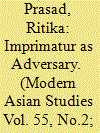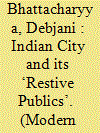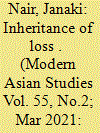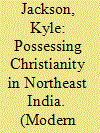|
|
|
Sort Order |
|
|
|
Items / Page
|
|
|
|
|
|
|
| Srl | Item |
| 1 |
ID:
177982


|
|
|
|
|
| Summary/Abstract |
In the progression of stages toward unintended lives, the two stops on either side of abortion—contraception and infanticide—have been studied extensively by historians of South Asia. We know much less about abortion, particularly during the colonial period. Drawing upon published judgments, unpublished case records, forensic toxicology reports, and treatises on Indian medical jurisprudence, this article suggests that anti-abortion law was generally enforced in colonial India only when women died as a result of illegal abortions. This approach was contrary to the Indian Penal Code (IPC), which criminalized most abortions even when the women survived. The pattern was a continuation of the pre-IPC approach in India. This article explores possible explanations for the lax enforcement of anti-abortion law in South Asia during the late nineteenth and early twentieth centuries, considering abortion as experienced by South Asian and British women alike. It proposes as contributing factors: challenges in detection, the social movement for the protection of Hindu widows, colonial anxieties about false allegations of abortion among South Asians, the common phenomenon of imperial (British) husbands and wives living apart, and physicians’ desire to protect doctor–patient confidentiality. The article focuses on two key cases involving abortion: the Whittaker-Templeton case from Hyderabad (1896–1902) in which a British woman died following an abortion; and the Parsi matrimonial case of T. v. T. from Bombay (1927), in which a Zoroastrian woman alleged that her pharmacist husband had forced her to terminate three pregnancies by ingesting drugs.
|
|
|
|
|
|
|
|
|
|
|
|
|
|
|
|
| 2 |
ID:
177987


|
|
|
|
|
| Summary/Abstract |
This article reinterprets the Indonesian invasion of East Timor as a ‘diplomatic counter-revolution’. Using the central archival records of the Suharto regime for the first time in English-language scholarship, it unearths a diplomatic campaign undertaken by agents of the New Order to secure international support for an Indonesian invasion of East Timor. This diplomatic offensive spanned Southeast Asia, non-aligned and Afro-Asian networks, Western capitals, international institutions and media circuits, and global capital markets. Its success tipped the balance of power in Jakarta away from advocates of restraint like Adam Malik and towards advocates of annexation like Ali Murtopo. The diplomacy behind Indonesia's invasion of East Timor reveals that the architecture of globalization, lauded by some scholars as inherently liberatory, was in fact agnostic, capable of being turned to counter-revolutionary purposes in addition to revolutionary ones. And it suggests that diplomacy itself had been counter-revolutionized, as geopolitical and geoeconomic change combined to make the international system, particularly the states of the Global South, far more hostile to state-making claims and transformative world-making projects.
|
|
|
|
|
|
|
|
|
|
|
|
|
|
|
|
| 3 |
ID:
177988


|
|
|
|
|
| Summary/Abstract |
Between March and May 1954, an election and two riots took place in East Pakistan, with far-reaching implications. On 30 May, the prime minister of Pakistan, in a bellicose tone, declared that ‘enemy agents’ and ‘disruptive forces’ were at work and imposed governor's rule for the first time in East Pakistan. The autocratic and high-handed attitude of the Central government in Karachi over the seemingly wayward East Wing was to become a portent of future conflicts between the province and the state, eventually leading to the unmaking of Pakistan in 1971. What precipitated the 1954 crisis? Who were the enemy agents and disruptive forces that the prime minister had alluded to? The reference was to the Bengali labourers in East Pakistan—the main protagonists of the 1954 Karnaphuli Paper Mill and Adamjee Jute Mill riots. These were the most violent industrial riots in the history of United Pakistan, if not the subcontinent. Using sensitive materials obtained from multiple archives, this article dismantles the conventional thesis that these riots were ‘Bengali–Bihari riots’, fanned by the flames of Bengali provincialism at the political level, or events instigated by the Centre to derail the democratic hopes of the Bengali population of Pakistan. A microhistory of the events demonstrates a more complex picture of postcolonial labour formations and solidarities; the relationship between state-led industrialization and refugee rehabilitation, and conflicting visions of sovereignty. This is a story of estrangement between employers and workers over the question of who were the real sovereigns of labour, capital, and Pakistan itself.
|
|
|
|
|
|
|
|
|
|
|
|
|
|
|
|
| 4 |
ID:
177980


|
|
|
|
|
| Summary/Abstract |
Examining cases of libel between 1780 and 1823, this article analyses how the theory and practice of press regulation and governmentality was initially articulated in colonial India, embodied in everyday transactions between the newly invented East India Company state and an emerging newspaper press. While Company officials recognized that scrutiny by a free press was central to establishing their fairly new claims to just governance and public legitimacy, they feared that public critique would destabilize the very sovereign authority that they sought to establish. Concerned with appearing arbitrary, officials developed strategies through which they could demand obedience without necessarily predicating it on censorship. Journalists derived much of their negotiating power from the early colonial state's vulnerability to public scrutiny, but they also knew that the state possessed extensive control over their livelihood. Cognizant of the power and constraints of colonial governmentality at this juncture, they produced their own mechanisms of permissible intransigence. This uneasy equilibrium generated the questions explored in this article: What rights of comment and critique practically accrued to newspapers? What was the legal authority of executive regulations censoring newspapers and how far were these enforceable? Why, in practice, did punishments remain strikingly similar across periods with and without formal censorship? The cases between 1780 and 1823 not only reveal the historical negotiations that structured this foundational—though somewhat marginalized—period of India's press history, but also explain the strategic shifts that followed as, in 1823, the fulcrum of crime and punishment turned away from press censorship and towards press licensing.
|
|
|
|
|
|
|
|
|
|
|
|
|
|
|
|
| 5 |
ID:
177989


|
|
|
|
|
| Summary/Abstract |
How do we write about cities in a world of deepening inequality, real-estate geopolitics, and the planetary water crisis that is unfolding in parts of Asia and elsewhere? Indian urban studies, which began to gain ground as a legitimate subject of scholarly enquiry two decades ago, has now emerged as a site to study political society, state-making, and citizenship, and to offer rich accounts of how post-colonial urban governance and law-making work. In this review, I explore the powerful analytics developed in three recent books in urban studies: Anindita Ghosh's historical work on colonial Calcutta, Claiming the City: Protest, Crime and Scandals in Colonial Calcutta, c. 1860–1920 (2016); Asher Ghertner's geographical analysis of neoliberal Delhi, Rule by Aesthetics: World-Class City Making in Delhi (2015); and Nikhil Anand's ethnographic account of restive publics and citizenship in Mumbai, Hydraulic City: Water and the Infrastructures of Citizenship in Mumbai (2017). This recent scholarship on urbanization has moved away from earlier rubrics of segregation, biopolitical disciplining, and resistance to offer rich accounts of the frictions that make and unmake political societies, critical tools to study the life of law in post-colonial cities, infrastructures as sites for the production of citizenship, and new financial and legal assemblages of risk-management, building lobbies, and syndicates around which urban politics is swirling. These accounts also deepen our understanding of the long genealogy of the contemporary moment, including populism, electoral politics, and post-colonial state-making. Indeed, the future of urban studies in a rapidly urbanizing world should be one that helps us to understand the nature of politics, contestations around legalities, environmental crises, and new financial geographies of power and dispossession.
|
|
|
|
|
|
|
|
|
|
|
|
|
|
|
|
| 6 |
ID:
177983


|
|
|
|
|
| Summary/Abstract |
In 1845, the banker Damodar Dass of Srirangapatna loaned a large sum of money to Maharaja Krishnaraja Wodeyar III of Mysore. For the next seven decades, until the unpaid debt was turned into public charity, the multiple claims of Damodar Dass's heirs to this inheritance led the colonial state and the Mysore government (especially after 1881) to form a substantial archive. Occupying the foreground of this archive were the legal dilemmas posed by the transition from direct to indirect British rule in Mysore, involving the fate of kingship, debt, reciprocality, and masculine honour. Other legal dilemmas concerned the relationship between scriptural and customary law and, in particular, the portability of customary law between regions that were unevenly exposed to Anglo-Indian legal regimes. The claims also reveal the important ways in which a new moral order was being shaped as the relationship between the colonial regime and the princely state (or later its bureaucracy) was defined and the status of four female heirs was called into question. Additionally, the archive has the potential to disturb the univocality of this statist discourse. A third narrative may be uncovered that involves the ‘small voices of history’. What hopes did this era of profound transformation hold for women of the non-domestic sphere? What, moreover, can the women in these archives be heard to say about the truth of their times?
|
|
|
|
|
|
|
|
|
|
|
|
|
|
|
|
| 7 |
ID:
177985


|
|
|
|
|
| Summary/Abstract |
In the aftermath of independence, obtained in 1948, the Burmese government launched a project to valorize and promote traditional medicine which comprised the institutionalization and standardization of the teaching, practice, and production of medicines. The government justified this project by asserting the importance of protecting and improving—in terms of both quality and accessibility—this precious national heritage. Having contributed to the maintenance of people's health for centuries, it was nevertheless under threat of vanishing because of the dominance of biomedicine and because traditionally it had been passed down through a plurality of lineages using an esoteric language. Although recognizing the official motivation behind this project, this article suggests that it was also motivated by the need to unify and ‘Burmanize’ the country in the name of nation-building. Indeed, constructing a medicine that could compete with biomedicine, if not overtake it, would help in marking the country's distance and autonomy vis-a-vis the West. Spreading a standardized medicine, largely based on the Burman tradition, across the country would help eliminate inter-ethnic differences as well as the esoteric elements inherent in traditional medicine that were perceived as a potential threat to the state's authority. While claiming to protect a national heritage, the state was in fact crafting a new heritage that complied with a specific image of the nation—a unified modern Buddhist nation—in order to help it attain its political goals. The article also discusses to what extent this project has been successful by examining the limits of its implementations and the response of healers and manufacturers.
|
|
|
|
|
|
|
|
|
|
|
|
|
|
|
|
| 8 |
ID:
177984


|
|
|
|
|
| Summary/Abstract |
In 1937, a spirit moved in the mountains of Northeast India. It presented local villagers with a visceral anticolonial vision, laicized religious practices, and offered alternative definitions of expertise and literacy that sidelined colonial and missionary authorities. Its message pulled together a complex range of clans, pilgrims, and roadworkers, and reconciled them according to contemporary local logics. This article uses the ‘Kelkang incident’ of the Lushai Hills District (today: Mizoram) to reverse the polarity of conventional writings on prophetic rebellion in two ways. First, it asks not how the colonial state dealt with a prophetic rebellion, but how a prophetic rebellion dealt with the state. Second, it asks not what the moving spirit of Kelkang symbolized, but what it did and how people interacted with it. Placing upland spirits, humans, terminology, and concepts at the centre of the analysis, the article argues that a more open-minded approach to the history of religion can better reveal processes of mediumship and rapidly indigenizing Christianities as well as the much broader malleability of concepts like ‘conversion’, ‘revival’, and ‘Christianity’.
|
|
|
|
|
|
|
|
|
|
|
|
|
|
|
|
| 9 |
ID:
177986


|
|
|
|
|
| Summary/Abstract |
This article investigates anarchist theory and practice in 1920s and 1930s imperial Japan. It deliberately focuses on concepts and interventions by a rather unknown group—the Nōson Seinen Sha—to highlight a global consciousness even among those anarchists in imperial Japan who did not become famous for their cosmopolitan adventures. Their trans-imperial anarchism emerged from a modern critique of the present and engagement with cooperatist communalist ideas and experiences in Asia, Russia, and Western Europe. Anarchists theorized and implemented new forms of living that challenged the forces of capitalism, imperialism, and increasing militarism. In doing so, they simultaneously positioned themselves against established conservative and fascist agrarianism as well as Marxist dogmatism in the socialist movement. Despite their repression by the imperial state, they offered a radical, universalist, yet pragmatic way of being in autarkic farming village communes that corresponded with similar ideas and movements worldwide.
|
|
|
|
|
|
|
|
|
|
|
|
|
|
|
|
|
|
|
|
|